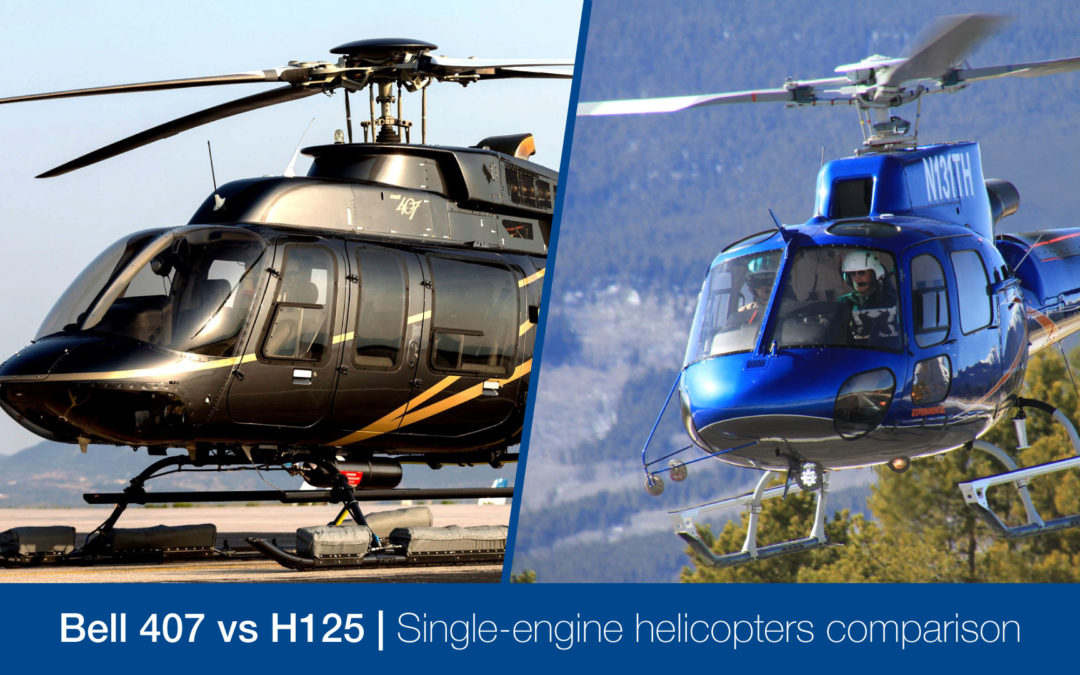Since no two aircraft is the same, it is sometimes hard to choose the right single-engine helicopter for your budget and your missions. Between a Bell 407, an Airbus H125, or the larger H130, differences are not significant but can influence your choice in the long run.
To help you in your next purchase, we decided to compare two of the most famous single-engine choppers out there: the Airbus H125 and the Bell 407GXi.
The Manufacturers
While we manage all types of aircrafts and don’t necessarily have a preference, there are some notable variations between the two manufacturers.
Airbus Helicopters, formerly known as Eurocopter, is a European manufacturer with French (and German) origins. It is the leader in the European market, and accounts for more than 41% of the Civil Helicopter fleet in South East Asia, with 1,748 units. Famous for its “Dauphin” (H155, formerly AS365), the king of Helicopter medevac, their aircrafts are widely used by pilots all over the SEA region, and you are likely to find a pilot with H125 rating quite easily.
Bell Helicopters, with 27% of the market share in South East Asia, is close behind. The American manufacturer from New York built the first helicopter to be rated by a civil aviation authority. More known for its military-grade helicopters, in particular, the famous UH-1 seen in the movie Apocalypse Now and vastly used during the Vietnam war, it was the manufacturer of choice for most of the Philippine Airforce fleet since the 1950s. It is however a very reliable civil helicopter constructor and one you should look into
Dimensions
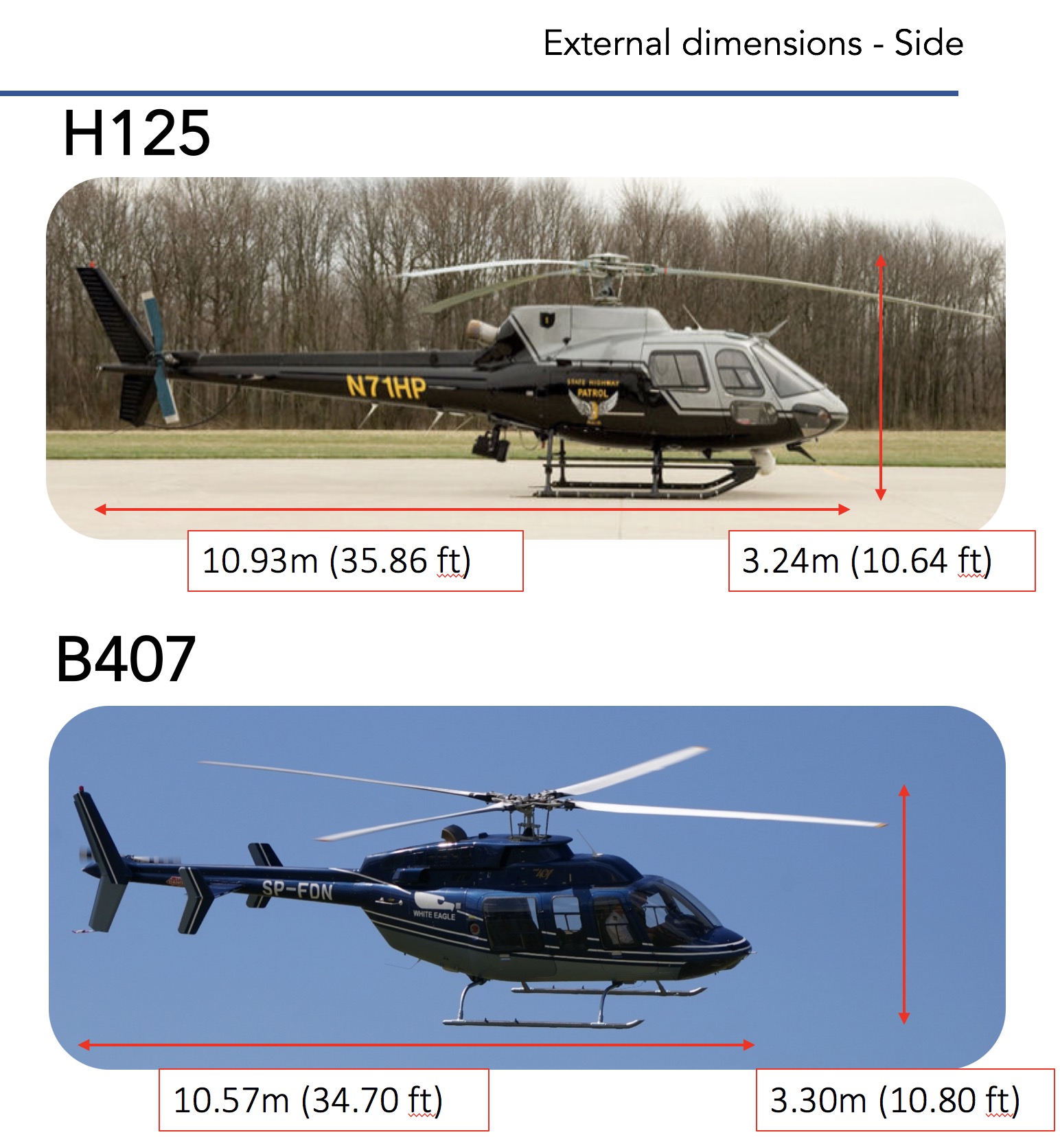
Both the H125 and Bell 407 display standard and similar dimensions, with about 10.5 to 11m length and 3.3m height. As it is common for single-engine helicopters of this grade, wingspan adds quite some length to the equation, although they would both fit in a regular hangar of an acceptable space.
Worth mentioning, the Bell 407 features 4 blades on its main rotor, which is sometimes slightly hard to manoeuver inside a hangar full of other aircrafts.
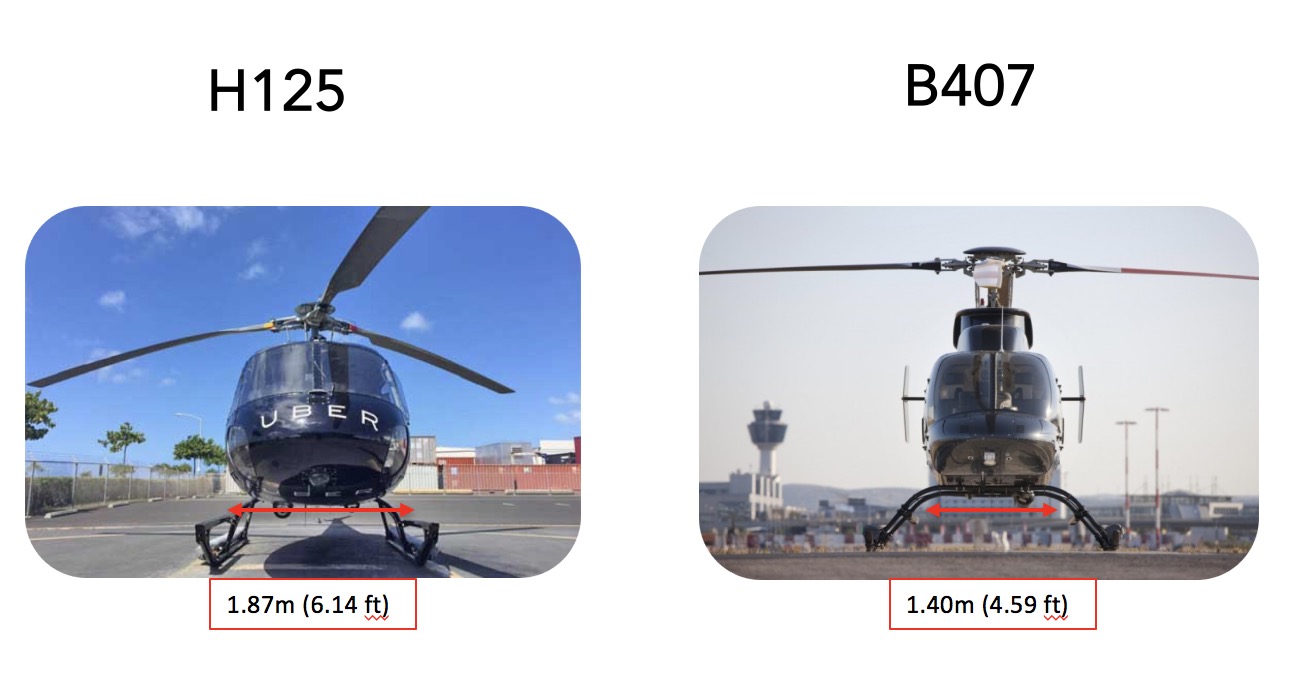
Cabin design
One of the main differences between the two aircrafts comes down to the cabin itself. Although both can take up to 6 passengers + one pilot, this configuration comes as standard for the Bell, whereas it requires what Airbus calls a “high density configuration” for the H125. Note that the H125 also comes with a more comfortable version, the “Stylence” where only 4 passengers sit comfortably in the back.
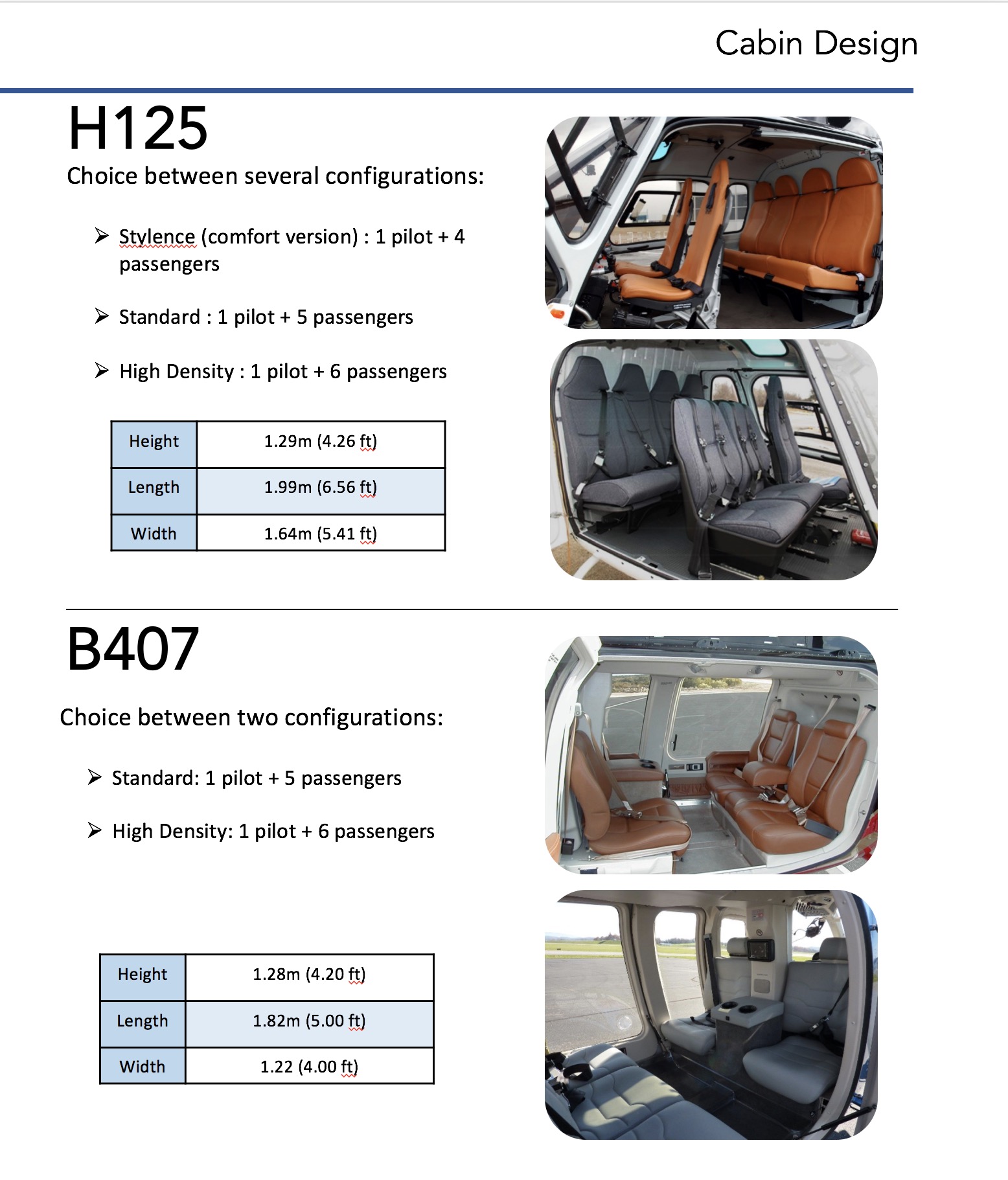
The second main difference is on seat placement. Bell is well known for its “Club” configuration, where the four seats face each other much like in a limousine or other luxury vehicles. Although this Club configuration is available on several other aircrafts of the Airbus range, this layout is not available for the H125.
Hence, if you are looking for an aircraft capable of welcoming guests and facing them while in the air, you might want to look into the 407.
Moreover, the Bell 407 features cabin/pilot separation: in other words, you are separated from the pilot by a window, that can only communicate with you through in-flight headphones. Although some owners prefer to have a close communication and relationship with their pilot, this layout is something to consider if your main goal is intimacy and transportation of VIPs.
The H125 however, is famous for its wide view and exceptional visibility of surroundings. You would feel much more involved in the flight on board an H125, and you are likely to prefer this aircraft if what you’re in for is sightseeing and discovery flights. Very often, it is the aircraft of choice for owners who also want to become pilots, as it is a much more “hands-on” aircraft.
As Ed Sale, from Airbus Helicopters explains, “One of the main helicopters in competition with the H125 is the Bell 407, which has a cabin separate to the cockpit, and it’s in a club form with two seats facing two seats. Some people love that because you have a separate cabin to the cockpit, and if you have a professional pilot you don’t have to talk to him, you can just say ‘fly me here along with my guests.’ It’s got good performance, but if you’re an owner-flyer you’ll choose the Airbus, since everyone sits up front and is involved, and can see what’s going on.” “It’s a question of whether you want a Maybach or a four-seat Ferrari. Both do a job, they’re both as good as each other, but they have a different market.”
| Features | H125 | B407 |
| Seats | 5 | 6 |
| Sound Proofing Cabin | Yes | Yes |
| Anti Vibration System | No | Yes |
| Sliding Door both sides | No, 1 (one) side only | Yes |
| Convert to club seating | No | Yes |
Another feature worth mentioning is the ability for the Bell 407 to slide both its side doors, when the H125 only has one of them configured as sliding. Although flying with doors open is usually less safe and reserved for missions operated by professionals, it may become a consideration if you intend to do a lot of Aerial Filming and Photography while riding your helicopter.
As for cabin size, the two aircrafts feature very similar measurements, although the cabin of the H125 is significantly wider:
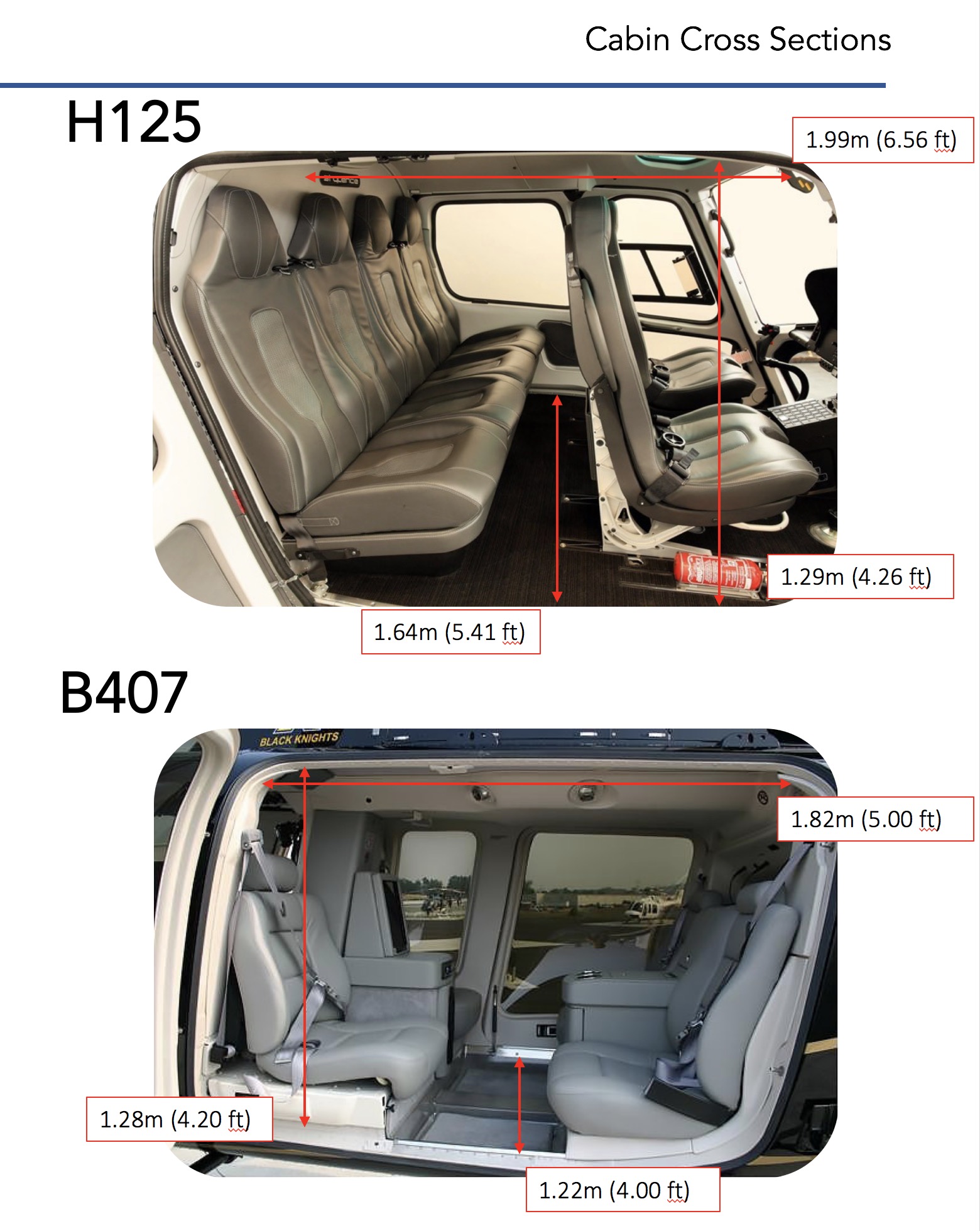
Performance
What about performance then? Once again, they are very similar between both helis. The H125, with a cruise speed of 251km/h and max speed of 287km/h, is usually considered a more “nervous” and “sporty” aircraft. It is often the aircraft of choice for flights that require extreme precision and fast or precise movement, like Aerial Filming or Cargo sling, due to its overall accurate reactivity and command responsiveness.
However, the cruise speed of the Bell being 246km/h with similar load, the 407 has nothing to be shy about. While considered more of a transport and leisure aircraft, it is very well capable of conducting aerial work missions such as Sling load and cargo transport, or aerial photography in some cases.
| PERFORMANCE AT MAX. GROSS WEIGHT, ISA, SL |
H125 |
BELL 407GXi |
||
| Maximum speed (VNE) | 287 km/h | 155 kts | 259 km/h | 140 kts |
| Fast cruise speed | 251 km/h | 136 kts | 246 km/h | 133 kts |
| Range with standard tank | 651 km | 351 NM | 624 km | 337 NM |
| Max Endurance without reserve at 100 km/h – 54 kts | 4 h 28 min | 4.0 hrs | ||
| Rate of climb | 10 m/s | 1,959 ft/min | ||
| Service ceiling | 5,044 m | 16,550 ft | 5,773 m | 18,940 ft |
| Hover ceiling IGE | 4,023 m | 13,200 ft | 4,130 m | 13,550 ft |
| Hover ceiling OGE | 3,383 m | 11,100 ft | 3,639 m | 11,940 ft |
The major distinction between both aircrafts is usually their range with a regular tank. When flying, the main metrics is the range (or max endurance) for a flight without using the reserve (which is only there as a “gas safety net” in case of emergency). Boasting half an hour more than the Bell 407, the H125 is a good option for flights that require a long period without any possibility for refueling, making it slightly more capable in inter-island flights and regions with large bodies of water like the Philippines.
|
Performance |
H125 |
B407 |
| Maximum Weight | 2,250 kg |(4,960 lbs) | 2,268 kg | (5,000 lbs) |
| Cargo-swing Load | 1,400 kg | (3,086 lbs) | 1,200 kg | (2,646 lbs) |
| Fast Cruise Speed/per hour | 251 km | (136 kts) | 246 km | (133 kts) |
| Take-off Power | 632 kW | (847 shp) | 643 kW | (862 shp) |
| Max endurance without reserve | 651 km | (351 nm) | 624 km | (337 nm) |
As you can see with the summary table above, numbers on performance are quite comparable between both aircrafts. The H125 would be recommended for aerial work missions due to its slightly enhanced capabilities, especially for cargo-swing load and cargo transport, as the additional 200kg it can carry could come handy for those types of missions. The Bell 407 is more adapted at pax transport but can perform almost as good as the H125 for most missions.
Operating costs
Here is a metrics on everyone’s lips: how much will each aircraft cost you every year? Operational costs are an important factor to consider if you want to manage your helicopter budget, as they can add-up quite fast and are often overlooked when purchasing your aircraft.
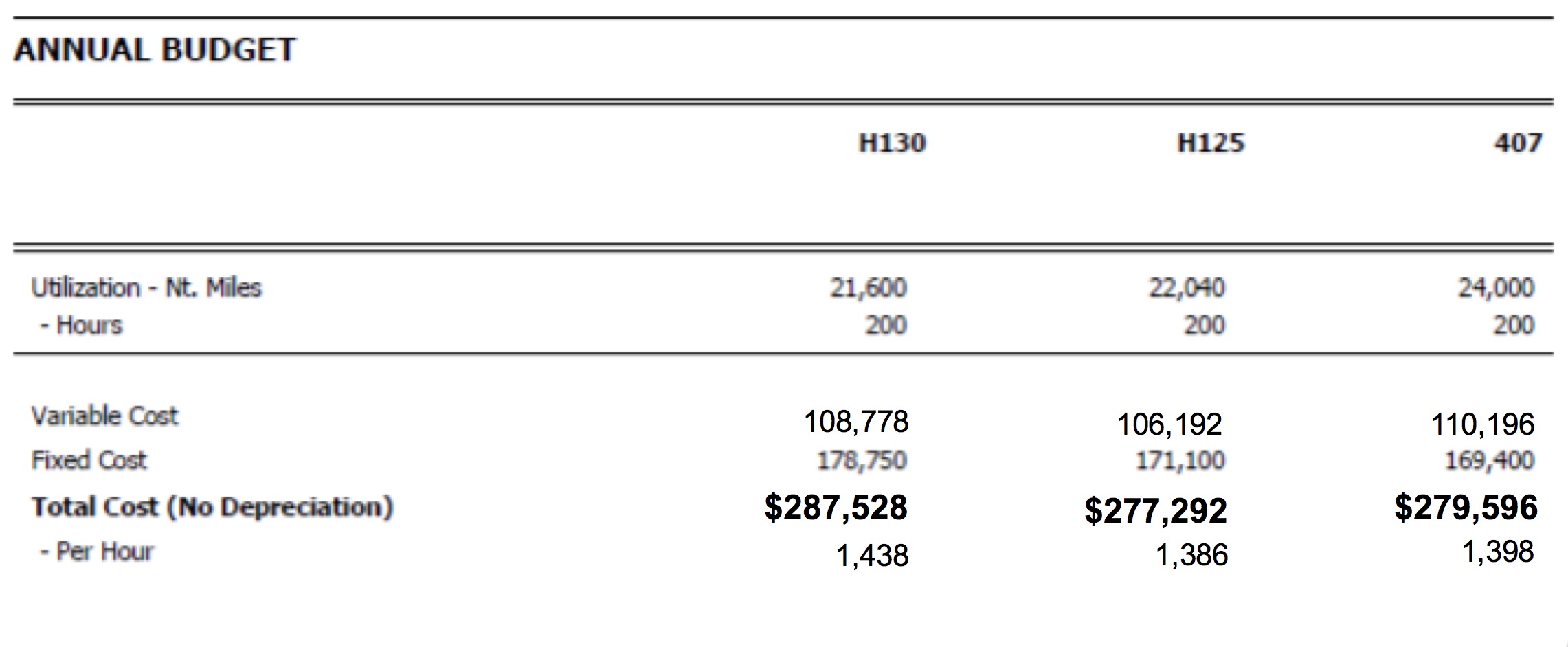
Once again, not a huge gap between the manufacturers. Yearly fixed costs are slightly higher for the H125 (and parts tend to cost a bit more for Airbus helicopters) but operating and variable costs are a bit lower than the Bell 407 due to smaller gas consumption.
| Variable costs | H125 | B407 |
| Fuel | $178.00 | $182.00 |
| Lubricants | $5.34 | $5.34 |
| Maintenance Labor (per hour) | $82.08 | $79.20 |
| Parts Airframe/Eng/Avion (per hour) | $69.00 | $69.56 |
| Engine Restoration | $120.17 | $118.14 |
| Major Periodic Maintenance | $76.37 | $96.74 |
| TOTAL VARIABLE COST/HOUR | $530.96 | $550.98 |
With a difference of only a few dozen dollars per hour for each aircraft, we feel operating costs do not represent a very clear differentiation factor.
Which one choose I pick? Comparison summary
So, you’ve reviewed the data we provided, now it’s time to choose, and you’re still lost? Here is a quick summary of each feature.
Choose the H125 if…
- You plan on piloting the aircraft yourself one day, or take piloting classes
- You are looking for a “sporty” and very responsive aircraft, similar to a sports car
- You plan on using the aircraft for Aerial work and technical missions requiring precision flying
- Unit cost: US$2.9M million (brand new)
Choose the Bell 407 if…
- You prefer executive or “Club” seating with seats facing each other
- You want a physical separation between passengers and your pilot, and look mainly for intimacy and VIP transportation
- You’re looking for comfort, in particular sound-proofing in the cabin
- You’re more interested in leisure than pure performance and power
- Unit cost: US$3.1M million (brand new)
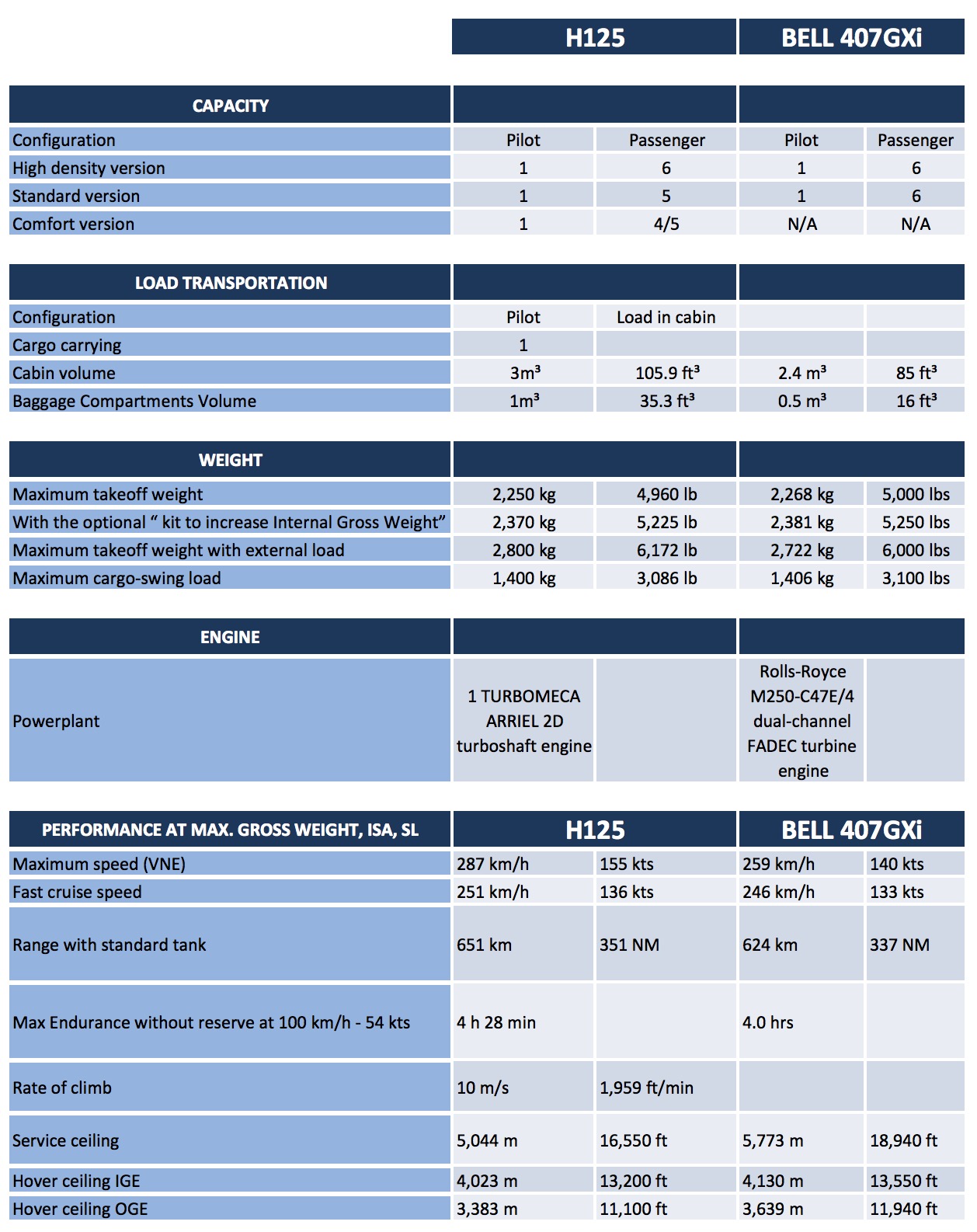
What aircraft do you prefer? Looking for a different comparison to help you choose? Let us know in the comments below!
